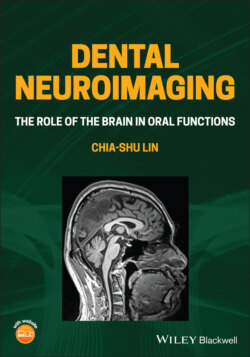Читать книгу Dental Neuroimaging - Chia-shu Lin - Страница 58
1.4.4 The Brain–Stomatognathic Axis
ОглавлениеWhile the OBB model emphasizes that the brain is critical to the stomatognathic functions, it does not directly account for the individual differences in feeding behaviour. The OBB framework suggests that a good stomatognathic condition (e.g. fully dentated) and the integrity of sensorimotor control of oral functions both contribute to good eating ability. However, the framework simplifies the association between the brain and oral health. In addition to sensorimotor control (which has been widely investigated via animal research), mastication and swallowing are also associated with cognitive, affective and motivational processing of the brain (Figure 1.3c). For example, as shown in Chapter 5, the tactile (e.g. ‘chewy’) and gustatory (e.g. ‘yummy’) experience from chewing is associated with an increased hedonic value and reward processing of food. Therefore, the brain–stomatognathic axis (BSA) framework highlights multiple associations between brain functions and feeding behaviour. Most importantly, the BSA framework highlights that all the functions participate in the adaptation of oral conditions. When dysfunction occurs (either due to structural deficits, aging or brain impairment), individuals also learn how to adapt to this new condition. For example, when having a meal, the patients with a new denture may keep on detecting if the denture is well fitted and judging if the food bolus is good to swallow. All the cases suggest that feeding behaviour is not a simple translation of oral sensory and motor functions. It is crucially associated with the attentional, cognitive, motivational and emotional processing related to eating.
In the BSA framework, the term ‘axis’ emphasizes a bi‐directional and dynamic relationship between the brain and the stomatognathic system (Lin 2018). In gastroenterology, the concept of ‘gut‐brain axis’ (GBA) has been proposed and widely distributed for many years. The GBA consists of ‘bidirectional communication between the central and the enteric nervous system, linking emotional and cognitive centres of the brain with peripheral intestinal functions’ (Carabotti et al. 2015). In parallel, the BSA emphasizes that the brain plays a more comprehensive role in sensorimotor and affective–cognitive processing on the stomatognathic functions and feeding behaviour.
